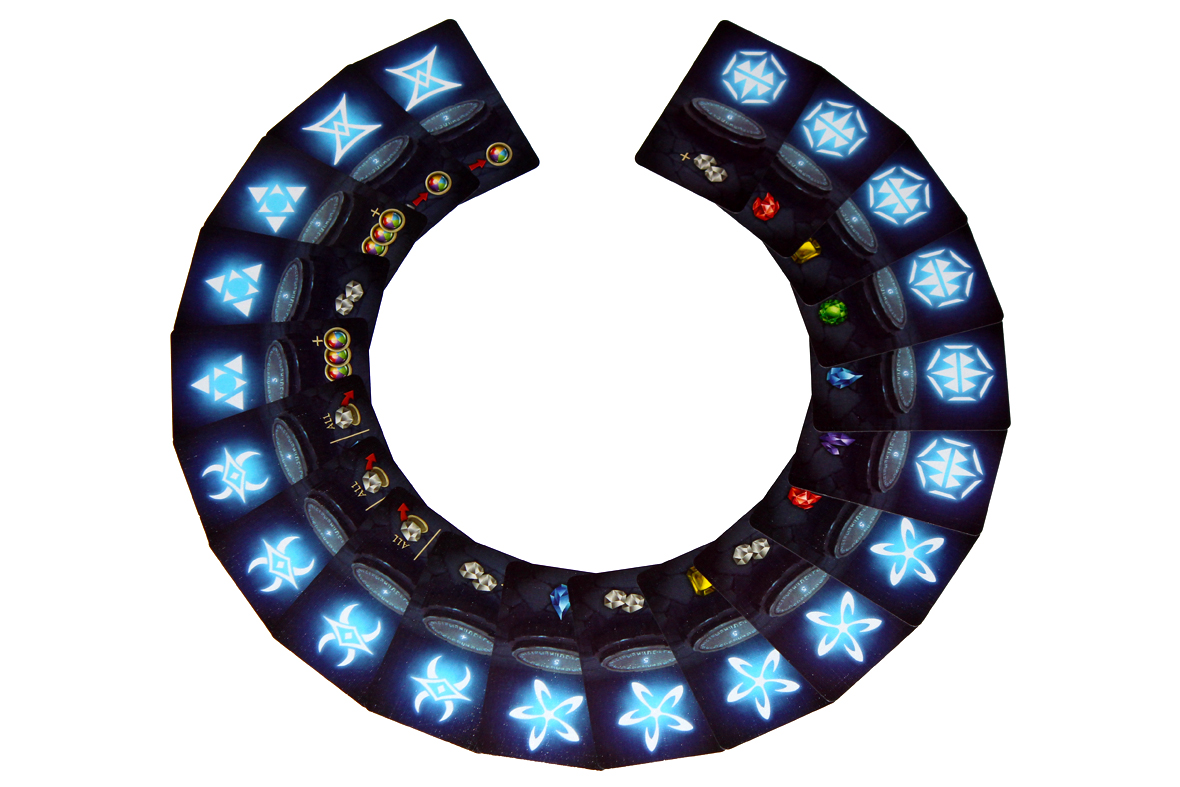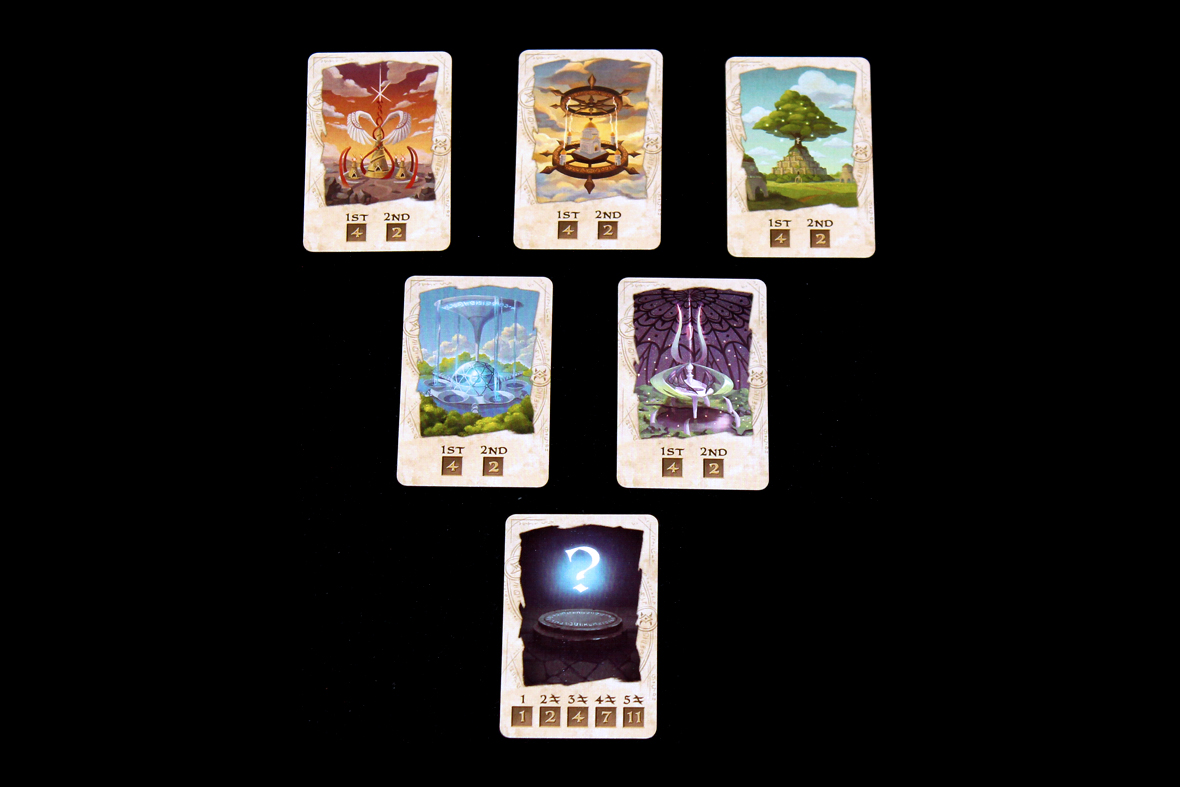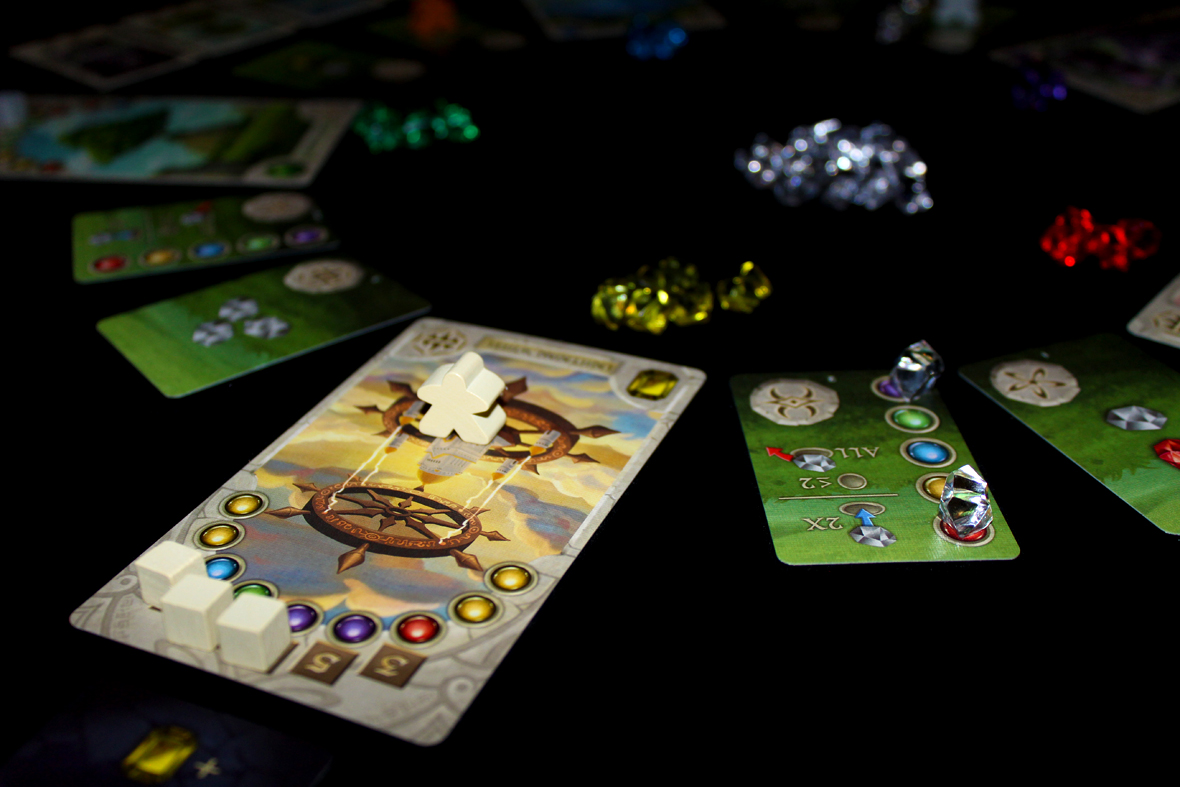
Base price: $25.
2 – 4 players.
Play time: ~30 minutes.
BGG Link
Check it out on Kickstarter!
Logged plays: 5
It’s been a pretty intense month as far as Kickstarter previews have been concerned — Unbroken’s on Kickstarter tomorrow, Fire in the Library, Cat Rescue, Flip & Find’s Diner, Highways & Byways, even Dream Catchers was at the tail end of last month, but, man, there are a lot of Kickstarter games. Weirdly enough this isn’t quite a preview — I bought Mystery of the Temples as an import game at BGG.CON and Deep Water Games is bringing it to the US in their Kickstarter, similar to their previous one for Herbalism.
In Mystery of the Temples, you play as cursebreakers traveling across the land to … well, break curses. You have to earn that title; it’s not like being an entrepreneur where you can just kind of say you’re one. But it might still involve bitcoin, so, there’s that. Anyways, you’ll need crystals to break the curses and breaking the curses will grant you powerful runes. Will you be the greatest cursebreaker in the land?
Contents
Setup
So the first thing you’re gonna want to do is set up the play area. That requires taking the temples (flipped to either the 2- / 3-player side or the 4-player side:

And putting them in a circle, each having two Wilderness cards in between them, in numerical order:

In a two-player game, remove Wilderness cards 4 and 7 after doing this. You should now have the main area set up:

Now, place all the crystals below their respective color temples, and leave the colorless crystals in the center:

Shuffle the Rune cards and split them into 5 equal stacks, placing each above a different temple:

You can flip the top rune card face-up and place it on the stack.
Now, give each player a Crystal Grid:

Each of those has different abilities, depending on which side they’re on:
- 1A: Every time you gain a colorless crystal, gain one more. Also, you only need to spend three colorless crystals to gain a crystal of any color.
- 1B: When you stop on a temple space, you may collect the crystal and break the curse, in either order.
- 2A: As soon as you gain this card, take three colorless crystals and put them on the empty spots. At any point, you may trade one of these colorless crystals in for a crystal of any color.
- 2B: When breaking a curse, you may spend 2 or 3 colorless crystals to also break a curse that is 1 or 2 levels higher. You must spend at least 3 crystals to use this.
- 3A: As soon as you gain this card, take a Rune card of your choice from the revealed Rune cards. You can use that Rune card for the entire game, but this Rune card and all Rune cards of the same type do not score for that Objective card.
- 3B: During movement, you may move to any unoccupied card. You must move to another space, though.
- 4A: Every time you set down a curse broken token, you gain the corresponding reward depending on how many curse broken tokens you’ve placed.
- 4B: When you gain a Rune card, you may take a Rune card from the adjacent Temple cards instead. At the end of the game, you have an extra type of Rune. If this means you have 6 different types of Runes, you gain 16 points.
You should not use these in your first game, but you’re fine to use them in subsequent games. You can deal them out randomly or draft them; your call. Have each player take a Cursebreaker and the curse broken tokens:

You’ll place one of those on the scoreboard:

Finally, take out the various bonus cards:

You’ll always play with the Rune Types Bonus (the one on the bottom). Take either 2 (2- to 3-players) or 3 (4 players) of the Temple Bonus cards and place them face-up near the play area, as well.
Give each player two colorless crystals and have them place them in any two spots on their Crystal Grid, and then the player with the lowest-numbered card starts!

Oh, also, if you’re playing at two players, take an extra Cursebreaker from the leftovers along with their curse broken tokens. Add the Cursebreaker to any one temple; they’ll be a dummy player for the game. Put their curse broken tokens on all the spaces on the top of temple cards with two dots underneath of them.
Gameplay

So, Mystery of the Temples is a pick up and deliver game with one of my favorite mechanics: moving in a circle. You probably heard me gush about it during my review of Sol: Last Days of a Star, and we’re back to it; what a time to be alive.
Your goal is to score the most points, but you score points by breaking curses. How do you break a curse? Well, look at the Temple cards:

If you look at the top, you can see which crystals are required to break the curse. However, you must spend them from your crystal grid by following a continuous path along your grid. Your first must be connected to the second must be connected to the third and so on. But how do you get Crystals?
Player Turn

On your turn, you must move 1 – 3 spaces along one of two tracks:
- Temple Track: You may only move on Temple cards this turn (skipping any Wilderness cards you would otherwise land on).
- Wilderness Track: You may only move on Wilderness cards this turn (skipping any Temple cards you would otherwise land on).
Once you pick a track, you move. If there is another player on a space on your track, you skip over them for no movement cost. You cannot land on the same space as another player.
- If you would like to move additional spaces, spend 1, 3, or 6 colorless crystals to move an extra 1, 2, or 3 spaces, respectively.
Once you land on a space, you may take that space’s action, but you may only choose one of these two actions:
- Collect Crystals: You may collect crystals from any space you land on, though some have a variety of different effects, such as:
- All Temples give you one crystal of their color.
- Some spaces let you spend three colorless crystals to gain two crystals of any two different colors.
- Some spaces let you place two colorless crystals on spaces on the card to gain the crystal of that space’s color. If this means that there are fewer than two open spaces, you should move all the crystals off the card and return them to the supply.If you have any Rune cards, you may activate what’s called a Rune Resonance if you’re collecting crystals on a space with a rune that matches your Rune card. This means you also activate the Rune card’s effect on that space, which usually gives you extra crystals.
- Break Curse (Temples only): At a temple, you may spend crystals from your Crystal Grid to break a curse. Place your curse broken token on the space corresponding to the last crystal you removed from your grid and score that many points. Also, take the top Rune card from that temple.
Also, at any point on your turn you may do any of these things:
- Spend 1 Colorless Crystal: Swap any two crystals on your Crystal Grid.
- Spend 4 Colorless Crystals: Gain a crystal of any color from the supply.
If there aren’t enough crystals of a certain color for you to gain one, take the crystal from the player with the most of that color. If there’s a tie, you pick. I’ve … never seen this happen, but the rule exists.
Also, you may use any crystal as a Colorless Crystal, regardless of its color. That’s an important one.
Once your turn is complete, the next player takes their turn. In a two-player game, also move the dummy player one space counterclockwise. They will kind of just casually block you from time to time.
End of Game

When any player has broken 5 curses, you enter the end game. Play until every player has had the same number of turns, and then check the Bonus Cards.
The Rune Types Bonus gives you extra points for every different kind of Rune card you have (the symbols). The dummy player in a two-player game ignores this one.
For the Temple Bonus, you gain points if you have the most or second-most curse broken tokens on the pictured temple. In a two-player game, the Dummy player can count for this one. If there’s a tie, split the points for that level equally between the players (if possible).
The player with the most points wins!
Player Count Differences
The major difference is there’s far more contention at four players than at two or three — there are only five temples, after all, and that doesn’t change with player count. The Wilderness expands to be a bit more accommodating, but you’ll find a lot of people vying for that extra Temple Bonus, so you better pay attention to what they’re trying to do and avoid getting surprised.
At four there’s a bit more blocking, as I mentioned, whereas at two you can stay fairly far apart (just watch out for the dummy player!). I have no real preference, but your play style may make you a bigger fan of one option over the other.
Strategy
- Go for that Temple Bonus. It’s free points. Plus, it really helps you get a lead if you get the 8 and the 5 from the same temple along with the Temple Bonus, since you also keep the Temple Bonus from other players.
- Rush the temples in a two-player game. If you have a two-score lead on another player, especially if you’re rushing the Bonus Temples, you’ve got a pretty good chance of taking the game. You just need to make sure you’re scoring enough with each one. It’s even better if you can also vary the runes that you’re collecting while you do that, so that you can get a higher score on the Rune Bonus.
- Collecting runes is always good. They give you extra abilities, they speed the game up, and they look super cool! What’s not to love, here? You should make sure to never grab the same type of rune twice, unless you can avoid it. That bonus for five different runes is huge.
- Leverage your player ability. If you have a player power, you should be using it. That’s just how player powers work. Try to figure out which actions best benefit your ability and then use those to chain together combos. For instance, you can use a number of the abilities to better obfuscate what your plan is (as you can gain crystals in nonobvious ways with some of them).
- You can manipulate the dummy player somewhat. It may be to your advantage to place yourself in the dummy player’s path so that they skip over you and block something that your opponent wants. It means you don’t have to take a bad turn and now your opponent can’t get to the space that they wanted. It’s a bit situational, but it works.
- Try not to telegraph your next play. It lets other players potentially block you. This is why I usually add crystals to the middle of my grid, and I try to shoot for combinations that can be used to break multiple curses. By the time they realize what you’re planning, it’ll hopefully be too late for them to stop you. Otherwise, yeah, they might block you and then you lose an entire round, effectively, unless you have a backup plan.
- Try to block your opponents if you can, but don’t waste time on that. Yeah, like I said, especially at higher player counts, blocking is going to be pretty difficult to do reliably. The fun part of the game is that you can generally predict what your opponents are planning by looking at their Crystal Grids. If you see certain patterns it may be worth stopping on those temples to gather crystals so that they can’t break the curse. I wouldn’t take something you don’t need, though; efficiency is going to be key to your success.
Pros, Mehs, and Cons
Pros
- I love the art. Wow, the Temples are striking. Each of them is super neat and thematic and kind of breathtaking. I’m almost upset there’s no lore about this world (or more temples in different colors that we could switch out. Quite frankly, I bought this game on box art alone (I’m that guy, sometimes), and I’m just glad that it had a super fun game to go with the wonderful art. It’s definitely one of the better-looking games I own.
- The circular movement is really peaceful and relaxing. I just like moving pieces in circles, a lot. It has a nice sort of order, to it. I’ve already mentioned how much I liked it in Sol, and doing so here is also very nice. I want to see more games with this concept.
- I like that rune collection accelerates the end of the game. It’s a nice touch for speeding up the game.
- The Crystal Grid system is super neat. I love that you have to plan out how you place your resources (and pay to swap them). It’s also neat because then it becomes a challenge as to how you can take crystals without explicitly telegraphing your next move to your opponents. That puzzle aspect is something I haven’t seen in many pick up and deliver games, and I like that you can potentially obfuscate your intentions.
- The blocking elements are solid but not terribly aggressive. It’s usually not personal, so I don’t find it aggravating like games with considerable amounts of take-that. It’s definitely a friendly game (though it could be friendlier without blocking).
- The dummy player is interesting. I like that it moves inexorably in the opposite direction. In almost every game I’ve played at two players, the dummy player shows up at least once to completely wreck your plans for a turn. It’s a nice touch, especially because it’s so simple to operate. The only real issue is that we often forget to move it.
- Pretty simple to learn. It’s a pick up and deliver game where you move in a circle and you have to deliver the crystals in a specific order. That’s nice and succinct, and I appreciate that.
- Very portable. All the EmperorS4 games in this line are super portable. It’s great! You can just throw them in a backpack and take them wherever.
Mehs
- I don’t really like scoreboards that are part of the game box. This one is just kind of mediocre. It’s difficult to see scores over the edges of the box, and that sort-of-begs the question of why have a score tracker at all? Hopefully they have a better solution for the Kickstarter Edition.
- The cursebreakers are kind of … odd color choices. If you’re talking about player colors for a game, are your first four choices black, grey, brown, and cream? No, probably not. I am sympathetic to the idea that the major five colors were already taken by the gems, but the cursebreaker tokens do very little for me in terms of excitement because the color scheme is pretty bland.
- The symbols aren’t always very intuitive. I feel like I’ve heard this debate a lot between various game designers about using pure iconography or using pure text and I haven’t seen a lot of like, “this always works in every case” solutions. For Mystery of the Temples, some of the icons are obvious, sure, but others are a bit confusing (especially with the player powers). It happens, but, still a meh.
Cons
- The gems are all the same shape, which is going to make things difficult if you’ve got any sort of altered visual perception. If you can’t tell the green gem from the blue gem from the red gem, you’re not going to have a great time organizing your crystal grid or breaking curses. It’s not something the base game does a particularly good job of addressing, either — Apotheca used different molds for the gems, but not only are these crystals the same, but the requirements to break a curse are all circles of specific colors. Symbols or something would really help make that less difficult for some. That said, it looks like they’re addressing this with the Kickstarter, so, this is more an issue with the version that isn’t coming from Deep Water Games.
Overall: 9 / 10

Overall, I’m enamored with Mystery of the Temples! I think it’s a lot of really cool things in a very small box. It’s generally pretty simple to learn (I apparently taught it in my sleep at BGG.CON; I was extremely tired that day and have no real memory of this.) I love the circular nature of the game both in layout and also in gameplay, not to mention the art is absolutely phenomenal. Extremely colorful and vibrant. The gems are nice, but the game is not totally accessible in its current state because of them (though I’ve heard rumors that Deep Water is working on that). If you’re looking for a neat pick up and deliver with some really great art, I’d highly recommend checking out Mystery of the Temples!
One thought on “#190 – Mystery of the Temples”